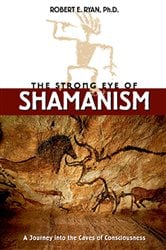
The Strong Eye of Shamanism | Free Book

• Not just an academic work. Helps the reader experience the actual mindset of the shaman
• Presents a cohesive view of the recurrent patterns of symbolism and visionary experience that underlie all religion
The human psyche contains archetypal patterns largely lost to contemporary society but which shamans have employed for over 30,000 years to gain access to the spiritual world. Shamanic symbols both affect and reflect these durative patterns that exist, with uncanny similarity, in civilizations separated by expanses of time and distance. The Strong Eye of Shamanism draws together the many facets of the art of shamanism, presenting a cohesive view of the recurrent patterns of symbolism and visionary experience that underlie its practice.
The "strong eye" of the title refers to the archetypal symbolism that sits at the foundation of all human life--whether in Paleolithic caves or today's temples. The author asserts that society has become separated from the power of those symbols that lead us into deeper understanding of our spirituality. In today's world of splintered psyches, a world in which people are in search of their souls, shamanism survives as an age-old technology of soul recovery, a living Rosetta stone that reminds us of the shared foundation that exists beneath even the most radically different perspectives. Through its study of shamanism, archetypal psychology, and symbolism, The Strong Eye of Shamanism encourages individuals--and society--to look inward and remember that the deepest forms of awareness begin with the knowledge that the answers reside within us.
In The Press
The Strong Eye of Shamanism: A Journey into the Caves of
Consiousness is a well-researched and lucidly written interpretive analysis of
certain archetypal shamanic journey themes found in the Paleolithic
rock art caves of southwestern France and northern Spain. Weaving
together archaeological research on European cave art, the archetypal
approaches of Jungian psychology and comparative symbology, and
ethnographic studies of shamanic initiation ceremonies in various
cultures, author Robert E. Ryan carefully develops his thesis that
these Paleolithic caves may have functioned as ritual
sanctuaries--natural cathedrals that may have been used for shamanic
initiations or for some other shamanic purposes.
Through
the process of examining a sampling of accounts of shamanic initiatory
journeys recorded in shamanic cultures around the world (including the
Samoyed of Siberia, the Aborigine of Australia, the Maya of Central
America, the Huichol of Mexico, and the Tukano of the Amazon), Ryan
does a good job of identifying many of the primary themes inherent in
shamanic trance journeys. For example, utilizing Reichel-Dolmatoff's
ethnographic research on the Tukano, he ably traces the archetypal
structural forms and motifs--such as feather crowns, feathered staffs,
and images of drowning and returning to the cosmic womb of
creation--that permeate Tukano shamanic practices and cosmological
myths. Drawing on the research of Peter Furst and Barbara Myerhoff, he
performs a similar analysis on archetypal themes involved in the
Huichol pilgrimage to Wirikuta, the holy homeland of peyote.
Ryan endeavors to show that the physical journey into the
Paleolithic caves of Europe . . . essentially reenacts the classic
shamanic journey into the underworld and that the content and
placement of images in the caves reflects the most fundamental and
universal patterns of shamanic initiation.
This volume
contains much stimulating and thought-provoking material that should
be of interest to shamanic practitioners.
Also read:
- Title: The Strong Eye of Shamanism | Free Book
- Author: Steven
- Created at : 2024-12-21 03:00:12
- Updated at : 2024-12-21 18:22:23
- Link: https://novels-ebooks.techidaily.com/95782076-9781620550618-the-strong-eye-of-shamanism/
- License: This work is licensed under CC BY-NC-SA 4.0.
